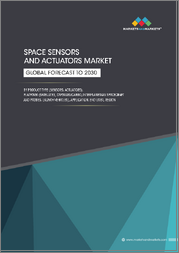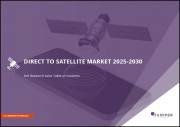
|
시장보고서
상품코드
1796486
위성 컴포넌트 시장 규모, 점유율, 성장 분석 : 컴포넌트 유형별, 궤도 유형별, 용도별, 지역별 - 산업 예측(2025-2032년)Satellite Component Market Size, Share, and Growth Analysis, By Component Type (Payload, Satellite Bus), By Orbit Type (Geostationary, Low Earth), By Application, By Region - Industry Forecast 2025-2032 |
||||||
세계의 위성 컴포넌트 시장 규모는 2023년에 147억 4,000만 달러에 달하며, 2024년 160억 7,000만 달러에서 2032년에는 320억 달러로 성장하며, 예측 기간(2025-2032년)의 CAGR은 8.99%로 성장할 전망입니다.
세계 위성 부품 시장은 빠르고 안정적인 연결성에 대한 수요 증가에 힘입어 강력한 성장세를 보이고 있습니다. 조직과 정부는 5G 커버리지를 강화하고 클라우드 서비스 및 실시간 분석 제공에 필수적인 원격지 IoT 용도를 촉진하기 위해 위성 네트워크를 활용하고 있습니다. 이러한 수요는 데이터 부하를 효율적으로 관리할 수 있는 첨단 트랜시버 모듈, 고처리량 안테나 등의 기술 혁신으로 이어지고 있습니다. 또한 소형화 추세는 비용 효율적인 임무를 위한 소형 위성 및 큐브샛(CubeSats)의 채택을 촉진하고, 자율성을 향상시키기 위한 엣지 컴퓨팅의 통합을 더욱 촉진하고 있습니다. AI의 발전은 운영의 신뢰성을 높이고, 실시간 이상 감지 및 예지보전을 가능하게 하고 있습니다. 이러한 개발은 위성 아키텍처를 재구성하고 업계에서 혁신적이고 지속가능한 미션 크리티컬한 솔루션을 위한 길을 열어줄 것입니다.
목차
서론
- 조사의 목적
- 조사 범위
- 정의
조사 방법
- 정보 조달
- 2차와 1차 데이터 방법
- 시장 규모 예측
- 시장의 전제조건과 제한
개요
- 세계 시장 전망
- 공급과 수요 동향 분석
- 부문별 기회 분석
시장 역학과 전망
- 시장 개요
- 시장 규모
- 시장 역학
- 촉진요인과 기회
- 억제요인과 과제
- Porter의 산업 분석
주요 시장 인사이트
- 주요 성공 요인
- 경쟁의 정도
- 주요 투자 기회
- 시장 에코시스템
- 시장의 매력 지수(2024년)
- PESTEL 분석
- 거시경제 지표
- 밸류체인 분석
- 가격 분석
- 기술 분석
- 사례 연구
위성 컴포넌트 시장 규모 : 컴포넌트 유형별 및 CAGR(2025-2032년)
- 시장 개요
- 페이로드
- 위성 버스
- 지상 설비
- 발사체
- 태양전지판
위성 컴포넌트 시장 규모 : 궤도 유형별 및 CAGR(2025-2032년)
- 시장 개요
- 정지궤도
- 저지
- 미디엄 어스
위성 컴포넌트 시장 규모 : 용도별 및 CAGR(2025-2032년)
- 시장 개요
- 커뮤니케이션
- 지구 관측
- 기타
위성 컴포넌트 시장 규모 및 CAGR(2025-2032년)
- 북미
- 미국
- 캐나다
- 유럽
- 독일
- 스페인
- 프랑스
- 영국
- 이탈리아
- 기타 유럽 지역
- 아시아태평양
- 중국
- 인도
- 일본
- 한국
- 기타 아시아태평양
- 라틴아메리카
- 브라질
- 기타 라틴아메리카 지역
- 중동 및 아프리카
- GCC 국가
- 남아프리카공화국
- 기타 중동 및 아프리카
경쟁 정보
- 상위 5사의 비교
- 주요 기업의 시장 포지셔닝(2024년)
- 주요 시장 기업이 채택한 전략
- 최근 시장 동향
- 기업의 시장 점유율 분석(2024년)
- 주요 기업의 기업 개요
- 기업의 상세
- 제품 포트폴리오 분석
- 기업의 부문별 점유율 분석
- 매출의 전년대비 비교(2022-2024년)
주요 기업 개요
- ServiceNow Inc.(USA)
- PlatCore(USA)
- Devoteam(France)
- Cask NX(USA)
- Crossfuze(USA)
- Infocenter(USA)
- Deloitte(United Kingdom)
- KPMG(Netherlands)
- Accenture(Ireland)
- DXC Technology(USA)
- NTT Data(Japan)
- EnableNow(USA)
결론과 제안
KSA 25.09.01Global Satellite Component Market size was valued at USD 14.74 Billion in 2023 poised to grow from USD 16.07 Billion in 2024 to USD 32 Billion by 2032, growing at a CAGR of 8.99% in the forecast period (2025-2032).
The global satellite component market is experiencing robust growth, propelled by the escalating need for high-speed, reliable connectivity. Organizations and governments are increasingly leveraging satellite networks to enhance 5G coverage and facilitate IoT applications in remote locations, essential for delivering cloud services and real-time analytics. This demand has led to innovations such as advanced transceiver modules and high-throughput antennas that manage data loads efficiently. Additionally, miniaturization trends are driving the adoption of small satellites and CubeSats for cost-effective missions, further supported by the integration of edge computing for improved autonomy. AI advancements are also enhancing operational reliability, allowing for real-time anomaly detection and predictive maintenance. These developments collectively reshape satellite architectures, opening avenues for innovative, sustainable, and mission-critical solutions in the industry.
Top-down and bottom-up approaches were used to estimate and validate the size of the Global Satellite Component market and to estimate the size of various other dependent submarkets. The research methodology used to estimate the market size includes the following details: The key players in the market were identified through secondary research, and their market shares in the respective regions were determined through primary and secondary research. This entire procedure includes the study of the annual and financial reports of the top market players and extensive interviews for key insights from industry leaders such as CEOs, VPs, directors, and marketing executives. All percentage shares split, and breakdowns were determined using secondary sources and verified through Primary sources. All possible parameters that affect the markets covered in this research study have been accounted for, viewed in extensive detail, verified through primary research, and analyzed to get the final quantitative and qualitative data.
Global Satellite Component Market Segments Analysis
The global satellite component market is segmented based on component type, orbit type, application, and region. In terms of component type, the market is divided into payload, satellite bus, ground equipment, launch vehicle, and solar panel. Based on orbit type, the market is trifurcated into geostationary, low earth, and medium earth. Based on applications, the market is grouped into communication, earth observation, and others. Based on region, the market is segmented into North America, Europe, Asia-Pacific, Central & South America and the Middle East & Africa.
Driver of the Global Satellite Component Market
One key market driver for the Global Satellite Component Market is the increasing demand for advanced satellite technology across various sectors, including telecommunications, earth observation, and defense. The growing reliance on satellite systems for communication, navigation, and data transmission has spurred significant investments in satellite component development, driving innovation and efficiency. Additionally, the rise of small satellites, or CubeSats, has led to the demand for miniaturized, cost-effective components that can enhance satellite capabilities without sacrificing performance. This trend towards modernization and expansion of satellite networks reflects a broader push towards connectivity and data accessibility in an increasingly digital world.
Restraints in the Global Satellite Component Market
One key market restraint for the global satellite component market is the high cost associated with research, development, and manufacturing of advanced satellite technologies. The intricate design and engineering processes required to ensure reliability and performance in harsh space environments necessitate substantial financial investments. This can limit market entry for smaller companies and startups that lack the capital to develop competitive products. Additionally, the complexity of integrating various components, adhering to stringent regulatory standards, and navigating international collaborations can further strain budgets, potentially stalling innovation and leading to delayed project timelines, ultimately hampering market growth.
Market Trends of the Global Satellite Component Market
The global satellite component market is witnessing a significant shift towards software-defined and reconfigurable systems, revolutionizing traditional satellite architecture. This trend emphasizes the development of payloads, antennas, and onboard processors that can be reprogrammed post-launch, granting operators the ability to dynamically modify frequencies, adjust coverage areas, and reallocate capacity as needed. Such flexibility addresses diverse mission requirements across multiple sectors, enhancing operational longevity and mitigating the frequency of expensive hardware replacements. This adaptability also allows for quicker responses to evolving demands in communication and imaging, positioning software-defined components as critical enablers of innovation and efficiency in satellite operations.
Table of Contents
Introduction
- Objectives of the Study
- Scope of the Report
- Definitions
Research Methodology
- Information Procurement
- Secondary & Primary Data Methods
- Market Size Estimation
- Market Assumptions & Limitations
Executive Summary
- Global Market Outlook
- Supply & Demand Trend Analysis
- Segmental Opportunity Analysis
Market Dynamics & Outlook
- Market Overview
- Market Size
- Market Dynamics
- Drivers & Opportunities
- Restraints & Challenges
- Porters Analysis
- Competitive rivalry
- Threat of substitute
- Bargaining power of buyers
- Threat of new entrants
- Bargaining power of suppliers
Key Market Insights
- Key Success Factors
- Degree of Competition
- Top Investment Pockets
- Market Ecosystem
- Market Attractiveness Index, 2024
- PESTEL Analysis
- Macro-Economic Indicators
- Value Chain Analysis
- Pricing Analysis
- Technology Analysis
- Case Studies
Global Satellite Component Market Size by Component Type & CAGR (2025-2032)
- Market Overview
- Payload
- Satellite Bus
- Ground Equipment
- Launch Vehicle
- Solar Panel
Global Satellite Component Market Size by Orbit Type & CAGR (2025-2032)
- Market Overview
- Geostationary
- Low Earth
- Medium Earth
Global Satellite Component Market Size by Application & CAGR (2025-2032)
- Market Overview
- Communication
- Earth Observation
- Others
Global Satellite Component Market Size & CAGR (2025-2032)
- North America (Component Type, Orbit Type, Application)
- US
- Canada
- Europe (Component Type, Orbit Type, Application)
- Germany
- Spain
- France
- UK
- Italy
- Rest of Europe
- Asia Pacific (Component Type, Orbit Type, Application)
- China
- India
- Japan
- South Korea
- Rest of Asia-Pacific
- Latin America (Component Type, Orbit Type, Application)
- Brazil
- Rest of Latin America
- Middle East & Africa (Component Type, Orbit Type, Application)
- GCC Countries
- South Africa
- Rest of Middle East & Africa
Competitive Intelligence
- Top 5 Player Comparison
- Market Positioning of Key Players, 2024
- Strategies Adopted by Key Market Players
- Recent Developments in the Market
- Company Market Share Analysis, 2024
- Company Profiles of All Key Players
- Company Details
- Product Portfolio Analysis
- Company's Segmental Share Analysis
- Revenue Y-O-Y Comparison (2022-2024)
Key Company Profiles
- ServiceNow Inc. (USA)
- Company Overview
- Business Segment Overview
- Financial Updates
- Key Developments
- PlatCore (USA)
- Company Overview
- Business Segment Overview
- Financial Updates
- Key Developments
- Devoteam (France)
- Company Overview
- Business Segment Overview
- Financial Updates
- Key Developments
- Cask NX (USA)
- Company Overview
- Business Segment Overview
- Financial Updates
- Key Developments
- Crossfuze (USA)
- Company Overview
- Business Segment Overview
- Financial Updates
- Key Developments
- Infocenter (USA)
- Company Overview
- Business Segment Overview
- Financial Updates
- Key Developments
- Deloitte (United Kingdom)
- Company Overview
- Business Segment Overview
- Financial Updates
- Key Developments
- KPMG (Netherlands)
- Company Overview
- Business Segment Overview
- Financial Updates
- Key Developments
- Accenture (Ireland)
- Company Overview
- Business Segment Overview
- Financial Updates
- Key Developments
- DXC Technology (USA)
- Company Overview
- Business Segment Overview
- Financial Updates
- Key Developments
- NTT Data (Japan)
- Company Overview
- Business Segment Overview
- Financial Updates
- Key Developments
- EnableNow (USA)
- Company Overview
- Business Segment Overview
- Financial Updates
- Key Developments



















